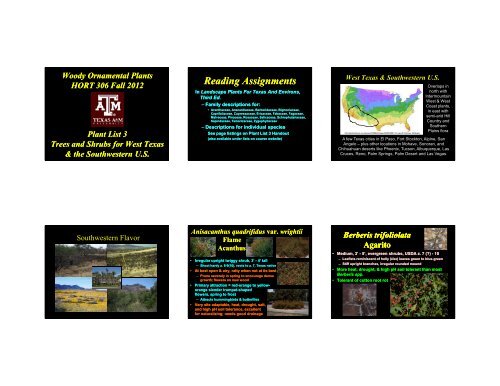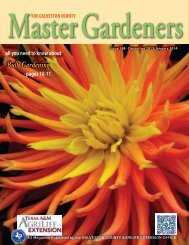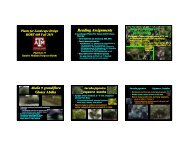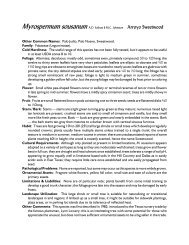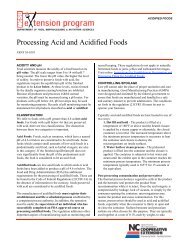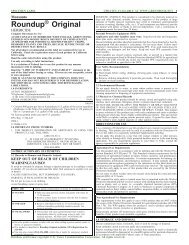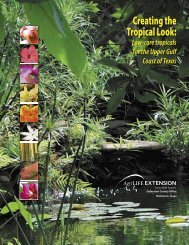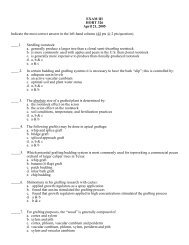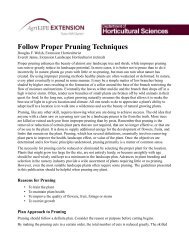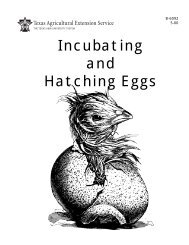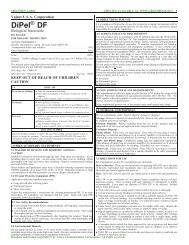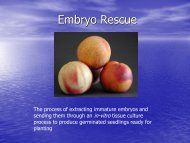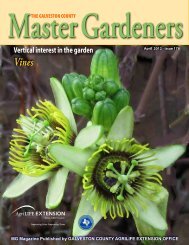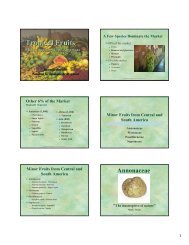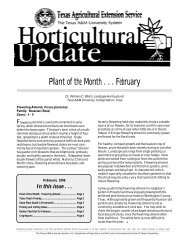Plant List 3 - Aggie Horticulture - Texas A&M University
Plant List 3 - Aggie Horticulture - Texas A&M University
Plant List 3 - Aggie Horticulture - Texas A&M University
You also want an ePaper? Increase the reach of your titles
YUMPU automatically turns print PDFs into web optimized ePapers that Google loves.
Woody Ornamental <strong>Plant</strong>s<br />
HORT 306 Fall 2012<br />
<strong>Plant</strong> <strong>List</strong> 3<br />
Trees and Shrubs for West <strong>Texas</strong><br />
& the Southwestern U.S.<br />
Southwestern Flavor<br />
Reading Assignments<br />
In Landscape <strong>Plant</strong>s For <strong>Texas</strong> And Environs,<br />
Third Ed.<br />
– Family descriptions for:<br />
• Acanthaceae<br />
Acanthaceae, , Anacardiaceae,<br />
Berberidaceae,<br />
Bignoniaceae<br />
Bignoniaceae, ,<br />
Caprifoliaceae<br />
Caprifoliaceae, , Cupressaceae<br />
Cupressaceae, , Ericaceae Ericaceae, , Fabaceae Fabaceae, , Fagaceae Fagaceae, ,<br />
Malvaceae<br />
Malvaceae, , Pinaceae,<br />
Rosaceae,<br />
Salicaceae,<br />
Schrophulariaceae,<br />
Sapindaceae<br />
Sapindaceae, , Tamaricaceae,<br />
Zygophyllaceae<br />
– Descriptions for individual species<br />
See page listings on <strong>Plant</strong> <strong>List</strong> 3 Handout<br />
(also available under lists on course website)<br />
Anisacanthus quadrifidus var. wrightii<br />
Flame<br />
Acanthus<br />
• Irregular upright twiggy shrub, 3’ - 4’ tall<br />
– Shoot hardy z. 8-9(10 9(10), ), roots to z. 7, <strong>Texas</strong> native<br />
• At best open & airy, ratty ratty when when not not at its its best<br />
– Prune severely in spring to encourage dense<br />
growth; flowers on new wood<br />
• Primary attraction = red red-orange orange to yellow-<br />
orange slender trumpet trumpet-shaped shaped<br />
flowers, spring to frost<br />
– Attracts hummingbirds & butterflies<br />
• Very site adaptable, heat, drought, salt,<br />
and high pH soil tolerance, excellent<br />
for naturalizing; needs good drainage<br />
West <strong>Texas</strong> & Southwestern U.S.<br />
http://planthardiness.ars.usda.gov/PHZMWeb/Images/300DPI/SIMP_US_lower48_fullzones_300dpi.jpg<br />
Overlaps in<br />
north with<br />
Intermountain<br />
West & West<br />
Coast plants,<br />
in east with<br />
semi-arid Hill<br />
Country and<br />
Southern<br />
Plains flora<br />
A few <strong>Texas</strong> cities in El Paso, Fort Stockton, Alpine, San<br />
Angelo – plus other locations in Mohave, Sonoran, and<br />
Chihuahuan deserts like Phoenix, Tucson, Albuquerque, Las<br />
Cruces, Reno, Palm Springs, Palm Desert and Las Vegas.<br />
Berberis Berberis trifoliolata<br />
Agarito<br />
• Medium, 3’ - 5’, evergreen shrubs, USDA z. 7 (?) - 10<br />
– Leaflets reminiscent of holly (Ilex lex) ) leaves green to blue blue-green green<br />
– Stiff upright branches, irregular rounded mound<br />
• More heat, drought, & high pH soil tolerant than most<br />
Berberis spp spp.<br />
• Tolerant of cotton root rot
Berberis trifoliolata Agarito<br />
• Spiny leaves are maintenance liability<br />
• Grow on well drained soils only<br />
• Accent, barrier plant, naturalizing,<br />
xeriscapes<br />
xeriscapes, , hedges, low screen<br />
Fallugia paradoxa<br />
Apache Plume<br />
• Tolerant of reflected heat, drought, high pH soils<br />
• Avoid wet or poorly drained soils soils, , or high relative<br />
humidity; cold tolerance varies with provenance;<br />
best treated as subshrub<br />
• Mostly deciduous to semi-evergreen<br />
semi evergreen<br />
woody shrub in USDA z. 9 -11 11, , subshrub<br />
or herbaceous herbaceous perennial perennial in z. z 8(7b) 8 (7b)<br />
• Foliage is open at best, ratty if not<br />
periodically pruned, 1’ to 33’<br />
’ (5’) ( 5’) tall<br />
• Pink hibiscus hibiscus-like like flowers are best feature<br />
• Tolerates much heat and drought, some<br />
salts; requires well drained soils & sun<br />
• Xeriscapes<br />
Xeriscapes, , naturalizing, southwestern<br />
landscapes, informal perennial and mixed<br />
borders, perhaps rock gardens<br />
Eysenhardtia texana<br />
<strong>Texas</strong> Kidneywood<br />
• A fine textured open canopy<br />
deciduous shrub, 6’ to 8’ (15’) tall<br />
• USDA zones 7 - 10<br />
• Scraggly in the wild, denser under<br />
cultivation<br />
• Small white to creamy white<br />
fragrant flowers in 1” - 4” racemes<br />
• Heat, H d drought, h and d high hi h pH H soil il<br />
tolerant<br />
• Naturalizing, xeriscapes<br />
xeriscapes, , mixed<br />
border, good bee tree<br />
Pavonia lasiopetala<br />
Rockrose<br />
Fallugia paradoxa<br />
Apache Plume<br />
• Medium size irregularly<br />
rounded shrub with semi-<br />
evergreen fine textured<br />
dark green foliage<br />
• USDA z. 33-10<br />
10 with proper<br />
provenance selection<br />
• Solitary single 1” rose rose-like like<br />
flowers, peak in spring,<br />
sporadically to frost<br />
• Achenes with filamentous<br />
feathery persistent styles,<br />
white white-tan tan flushed pink or<br />
purple, showy<br />
Larrea tridentata<br />
Creosote Bush<br />
• One of the most widespread shrubs in the native flora<br />
of West <strong>Texas</strong> and SW USA, hardy USDA z. 8 (7) ( 7) to 11<br />
• Irregular broadly mounded small to medium<br />
evergreen shrub shrub, , aromatic foliage<br />
• Interesting small yellow flowers and fuzzy fruit
•• Extremely Extremely drought drought,<br />
heat, and wind tolerant<br />
• Difficult to transplant,<br />
use small container<br />
grown plants, intolerant<br />
of poor drainage<br />
• Will accept shearing<br />
Larrea tridentata<br />
Creosote Bush<br />
Leucophyllum candidum<br />
Violet Silverleaf<br />
• Silver white foliage and violet flowers<br />
• Smaller more compact plant than L. frutescens<br />
• Intolerant of poor drainage, high humidity, use<br />
i in semi-arid semi i arid id t to arid id portions ti of f USDA z. 7 - 11<br />
Leucophyllum<br />
frutescens<br />
<strong>Texas</strong> Sage<br />
• Small to medium evergreen native <strong>Texas</strong> shrub<br />
– Green to superior silver silver-gray gray foliage, 4’ - 8’ tall tall<br />
– T Tendency d to t open l leggy / / scraggly l h habit bit if if not t pruned d<br />
• Attractive bell bell-shaped shaped pink pink-purple purple to white flowers<br />
– Peak bloom in spring, summer flushes after rain events<br />
Image courtesy of Dr. Wayne Mackay<br />
• An outstanding small<br />
evergreen tree for West <strong>Texas</strong><br />
• Four season appeal<br />
– Clusters of white Pieris Pieris-like like<br />
spring flowers<br />
– 2” - 3” clusters of red berries,<br />
late summer - early winter<br />
– Attractive broad-leaved<br />
broad leaved<br />
evergreen foliage<br />
– Exfoliating white, tan, orange,<br />
apricot to red brown bark<br />
Arbutus xalapensis<br />
<strong>Texas</strong> Madrone<br />
Leucophyllum frutescens<br />
<strong>Texas</strong> Sage<br />
• Extreme heat & drought<br />
tolerance, takes high pH soils<br />
• Intolerant of poor drainage, avoid<br />
high g relative humidity y regions g<br />
• Good xeriscape plant, hardy in<br />
USDA zones 8 (7) - 11<br />
• Tolerates heat,<br />
drought, high<br />
pH soils<br />
• Hardy USDA<br />
z. 7b (7a) - 10<br />
• Intolerant of poor drainage and<br />
high relative humidity<br />
• Slow to establish in landscape,<br />
difficult to transplant<br />
Shorn as formal hedge<br />
Arbutus xalapensis<br />
<strong>Texas</strong> Madrone
Acacia greggii<br />
Catclaw Acacia<br />
• Small tree / large shrub, 20’ - 30’ tall, hardy z.7 - 10<br />
• Creamy white flowers, numerous vicious thorns<br />
• Acacias can be limbed up or sheared sheared, barrier plants<br />
Prosopis glandulosa<br />
Honey Mesquite<br />
• Irregular spreading deciduous rounded crown<br />
• One of most widely distributed trees in <strong>Texas</strong><br />
• Several desirable ornamental features;<br />
– Ferny fine textured foliage, filtered shade, fruit and flowers<br />
can be attractive, adapted to almost any site<br />
• Small, 15 15’ - 20’, 20 20’, , deciduous deciduous or<br />
semi semi-evergreen evergreen tree<br />
• South <strong>Texas</strong> tree naturalized<br />
further north<br />
• Several interesting features;<br />
bright green trunk, fine textured<br />
leaf, filtered shade, yellow flowers<br />
• Relatively short-lived, short lived, cold hardy<br />
only to z. 8b (8a) - 11<br />
• Problems:<br />
– Thorns can rival those<br />
of Gleditsia triacanthos<br />
– Takes over pasture land<br />
– Difficult to transplant<br />
– Allergenic pollen<br />
– Looks rough in winter<br />
Parkinsonia aculeata<br />
Retama<br />
Prosopis<br />
glandulosa<br />
Honey<br />
Mesquite<br />
Parkinsonia aculeata<br />
Retama<br />
• Thorns maintenance liability, can be<br />
weedy<br />
• Very site adaptable, cold &<br />
excessively wet soils are limiting,<br />
drought, heat, salt & alkaline soils OK<br />
Chilopsis linearis<br />
Desert Willow<br />
• Small, 15’ - 20’, deciduous tree, USDA z. 7 (6b?) - 10<br />
– Irregular rounded crown, single or multi multi-trunk, trunk, brittle<br />
– Open canopy, filtered shade, movement in breezes<br />
• Catalpa Catalpa-like like flowers in small terminal panicles<br />
– Heavy bloom in spring, sporadic individual flowers and<br />
lesser flushes following rain events through mid mid-fall fall<br />
– White, light pink to maroon pink, bicolors, musky scent
Chilopsis linearis<br />
Desert Willow<br />
• Rapid grower; limestone soil,<br />
salt, heat, drought tolerant, but<br />
intolerant of poorly drained soils<br />
• Super patio or accent tree,<br />
picturesque, but messy capsules<br />
Cercis canadensis var. texensis<br />
<strong>Texas</strong> Redbud<br />
• Smaller, Smaller, more drought and<br />
alkaline soil tolerant than<br />
C. canadensis canadensis var.<br />
canadensis<br />
• Smaller dark glossy green<br />
leaves with with more undulate<br />
margins than than on C.<br />
canadensis var. canadensis<br />
• Round crown open deciduous<br />
tree, 15’ - 25’<br />
• Bright yellow 1” powderpuff<br />
powderpuff-like like<br />
flowers, spring g to frost<br />
• Very drought and heat tolerant,<br />
hardy in USDA zones 7 - 10<br />
• Casts filtered shade<br />
• Brittle wood subject to<br />
wind / ice / snow damage<br />
• Good small tree for West <strong>Texas</strong><br />
and arid regions; slow to<br />
establish, hat-rack hat rack appearance<br />
when young<br />
Leucaena retusa<br />
Goldenball Leadtree<br />
Cercis canadensis var. mexicana<br />
Mexican Redbud<br />
• Even smaller, more drought,<br />
and alkaline soil tolerant than<br />
C. canadensis var. texensis<br />
• Even smaller, more glossy, and<br />
undulate margins than on<br />
C. canadensis var. texensis<br />
Cercis<br />
canadensis var.<br />
Cercis canadensis<br />
Three Varieties of Redbud<br />
Hybrid<br />
swarm<br />
texensis Cercis<br />
canadensis<br />
var.<br />
canadensis<br />
Cercis<br />
canadensis var.<br />
mexicana<br />
Courtesy Rowman & Littlefield Publ. Group; redrawn from originals by Benny J. Simpson<br />
Rhus glabra<br />
Smooth Sumac<br />
• Small moderately coarse<br />
textured tree / large shrub<br />
• Foliage in umbrella-<br />
shaped crown, 10’ - 15’<br />
tall<br />
• O Outstanding di red d f fall ll color l<br />
even in warm temperate<br />
regions, panicles of red<br />
drupes on female plants<br />
• Tends to form colonies<br />
from suckers, hardy in<br />
USDA z. 4 (3) -9 • Any sunny site not<br />
permanently wet<br />
• Can be weedy<br />
Naturalizing, bank<br />
stabilization,<br />
highway plantings,<br />
wildlife food
Rhus lanceolata<br />
Prairie Flameleaf Sumac<br />
• More refined than R. glabra<br />
• Excellent fall color<br />
• Bit less suckering than<br />
R. glabra, but it still<br />
can b be weedy d in i<br />
manicured settings<br />
• Tolerant of heat, drought,<br />
& limestone soils<br />
• A <strong>Texas</strong> native, probably<br />
useful in USDA z. 66-9<br />
• Somewhat short short-lived, lived,<br />
needs well drained soils<br />
Sophora secundiflora<br />
<strong>Texas</strong> Mountain Laurel<br />
• Medium / large evergreen shrub / small tree<br />
• Sun to part shade, requires good drainage,<br />
z. 8 - 10, <strong>Texas</strong> native, best on alkaline soils<br />
Sambucus mexicana<br />
Mexican Elder<br />
• Small picturesque semi-<br />
evergreen tree, 15’-20’ 15’ 20’<br />
• Picturesque thick contorted<br />
stems, spreading rounded<br />
crown, resembles big bonsai<br />
plant<br />
• Creamy white late winter to<br />
early summer flower clusters<br />
• Tends to grow late in<br />
autumn; poor fall acclimation<br />
can result in cold damage in<br />
USDA z. 8; short-lived; short lived; can<br />
become weedy; brittle wood<br />
• Intolerant of poor drainage,<br />
but needs water<br />
Ungnadia speciosa<br />
Mexican<br />
Buckeye<br />
• Large deciduous multi multi-trunk trunk<br />
shrub / small tree, 10’ - 12’ (30’)<br />
– Not a true Buckeye ( (Aesculus Aesculus<br />
spp spp.), .), called buckeye due to<br />
resemblance of seed to<br />
Aesculus spp.,<br />
poisonous fruit<br />
• Interesting spring pink to rose<br />
flowers, overall effect resembles<br />
that of Cercis canadensis<br />
– Unfortunately may be<br />
concurrent with foliage<br />
emergence<br />
Sophora secundiflora<br />
<strong>Texas</strong><br />
Mountain<br />
Laurel<br />
• Dark glossy green foliage, racemes of<br />
purple to pink pink-purple purple flowers, spring<br />
– Strong fragrance, grape bubble bubble-gum gum scent<br />
– Poisonous bright red seeds seeds, , used in crafts<br />
• <strong>Texas</strong> native, excellent heat & drought<br />
tolerance<br />
– Requires moderately good drainage<br />
• Good naturalizing plant, xeriscapes<br />
xeriscapes, ,<br />
shrub s ub borders bo de s<br />
• Can be limbed up into small patio tree<br />
• Often has good yellow fall color<br />
Ungnadia speciosa<br />
Mexican Buckeye
Vauquelinia<br />
angustifolia<br />
Chisos<br />
Rosewood<br />
Rosewood<br />
• A medium shrub to small tree, 8’ to 12’<br />
(20’) tall, hardy to USDA z. 7 – 9 ( (10) 10)<br />
• Handsome dark glossy evergreen<br />
leaves<br />
• Fragrant cyme cyme-like like clusters of small<br />
white flowers in late spring<br />
• Wi Wind d flutters fl tt leaves l<br />
• Extremely cold hardy, z. 2 – 9 (10)<br />
• Numerous problems, many<br />
common to most poplars;<br />
– Messy (leaves, fruit, twigs),<br />
weak wood, invasive roots,<br />
cankers, root rots, drop leaves<br />
in drought, weed problem<br />
Populus deltoides<br />
Eastern Cottonwood<br />
Vauquelinia angustifolia<br />
Chisos Rosewood<br />
• Very heat, wind, & drought<br />
tolerant, most any well drained<br />
soil, good West TX & SW US<br />
landscape shrub<br />
• Fireblight can be serious in humid climates<br />
• A medium size, 30’ to 50’,<br />
evergreen tree useful in<br />
USDA zones 8 - 11<br />
• Initially a strongly upright,<br />
becoming spreading and<br />
rounded with time<br />
• Very tolerant of heat and<br />
drought, withstands some soil<br />
salts and some alkalinity, very<br />
handsome bark<br />
• Needs well drained soils, may<br />
have problems with excess<br />
rainfall/high RH<br />
• Source of commercial cork<br />
Quercus suber<br />
Cork Oak<br />
• Large native deciduous tree<br />
along stream/river courses<br />
• Irregular upright oval to vase-<br />
shaped crown composed of 3<br />
or 4 main branches, very rapid<br />
growth rate<br />
• Coarse in leaf and winter<br />
habit, picturesque in native<br />
habitat, best left in large<br />
naturalized planting sites,<br />
60’ - 80’ tall common, 100’<br />
possible<br />
Populus deltoides<br />
Eastern<br />
Cottonwood<br />
Cupressaceae Cypress Family<br />
• A temperate to tropical gymnosperm family<br />
– 15 to 21 genera containing 100 to 125 species<br />
– Mostly trees, some shrubs, often resinous,<br />
coniferous, and evergreen<br />
– Scale Scale-like like to awl awl-like like leaves, often aromatic<br />
• Monoecious or dioecious dioecious;<br />
dioecious dioecious; ;<br />
– Males tiny yellow yellow-brown brown cones at branch tips<br />
– Females are persistent few few-valved valved woody cones or<br />
hard berries with waxy coatings<br />
• Important genera include: Calocedrus<br />
Calocedrus, ,<br />
Chamaecyparis<br />
Chamaecyparis, , Cupressus<br />
Cupressus, , Juniperus Juniperus, ,<br />
Platycladus<br />
Platycladus, , Thuja Thuja, , and Cupressocyparis
Cupressus<br />
arizonica<br />
Arizona Cypress<br />
• Medium / large evergreen tree<br />
• Attractive green to blue blue-green green foliage<br />
• Interesting shreddy red-brown red brown bark<br />
• Tolerant of hot, dry sites with alkaline<br />
soils, hardy in USDA zones 7 (6b) - 11<br />
• Avoid poorly drained sites,<br />
susceptible to borers and spider mites<br />
• Trunk cankers have been reported<br />
Juniperus<br />
scopulorum<br />
Rocky Mountain<br />
Juniper<br />
• Essentially a western counterpart to J.<br />
virginiana virginiana; ; intergrades in North <strong>Texas</strong><br />
• Native to to high high elevations elevations of of <strong>Texas</strong><br />
<strong>Texas</strong><br />
Panhandle, Guadalupe Mountains, and<br />
Arizona<br />
• Somewhat narrower crowned and of<br />
smaller, 30 ‘ to 40’, stature than J.<br />
virginiana<br />
• Tolerates less heat [z. 3-7 7 (8)] ( 8)] and humidity<br />
than J. virginiana virginiana, , but otherwise culture is<br />
similar with good drought resistance<br />
• Narrow cultivars, such as ‘Skyrocket’ are<br />
popular in the trade<br />
Image courtesy of Benny Simpson<br />
Cupressus<br />
sempervirens<br />
Italian<br />
Cypress<br />
• Classic spire spire-like like silhouette, 30’ to 40’ tall<br />
• Favorite for formal Mediterranean landscapes<br />
• Alternative to Lombardy Poplar for SW USA<br />
• Grows in most of our region, better adapted<br />
to drier portions of USDA zones 8 (7b) to 11<br />
• Avoid poorly drained soils and high RH<br />
• Juniper blight, spider mites, trunk cankers<br />
and root rots can be problems<br />
Pinus eldarica<br />
Afghan Pine<br />
• Pyramidal needled evergreen<br />
tree, 35’ 35’- 45’ (60’)<br />
• Christmas tree tree-like like conical<br />
growth form in youth, more<br />
sculpted and picturesque<br />
later in life<br />
• Fine Fine-textured textured wiry look<br />
• Cold hardy to USDA z. 6,<br />
tolerant of z. 9 heat<br />
Juniperus ashei<br />
Ash Juniper<br />
• Counterpart to J. virginiana in Hill<br />
Country y and p parts of West <strong>Texas</strong><br />
• Small evergreen tree, 15’ to 20’ (25’)<br />
• Important for wildlife; Golden<br />
Check Warbler nesting sites<br />
• Useful for similar purposes as J.<br />
virginiana virginiana, , but on drier sites<br />
• Needs well drained soils; drought<br />
and heat tolerant; hardy z. 7 (6) – 9<br />
• Ecological controversy; Pollen <br />
Pinus eldarica<br />
Afghan Pine<br />
• Good drought, heat, salt, and high pH soil<br />
tolerance, but intolerant of poor drainage<br />
– One of few pines to provide soft Eastern White Pine<br />
look in Central & West <strong>Texas</strong>,<br />
widely adaptable<br />
• Deserving of wider planting; tip moth problems?
Pinus cembroides<br />
Pinyon Pine<br />
• Group of taxa, small to medium trees,<br />
20’ 20’- 30’, with 1 to 4 evergreen needle-like needle like leaves<br />
– Sometimes separated into 5 species,<br />
P. cembroides, P. remota, P. edulis,<br />
P. monophylla, P. quadrifolia<br />
• Dense tear-drop tear drop-shaped shaped trees, slow growers<br />
• Need good drainage, heat, cold, drought, and<br />
limestone soil tolerant<br />
• Dark green to blue blue-green green foliage, important for<br />
wildlife cover and food, edible seeds<br />
Questions / Comments?<br />
All material represented herein are<br />
copyrighted by the author, or otherwise as<br />
indicated, with all rights reserved.<br />
For permission to reproduce text or<br />
images from this presentation write:<br />
Dr. Michael A. Arnold<br />
Dept. of Horticultural Sciences<br />
<strong>Texas</strong> A&M <strong>University</strong><br />
College Station, TX 77843 77843-2133 2133<br />
email ma ma-arnold@tamu.edu<br />
arnold@tamu.edu


